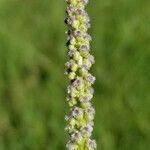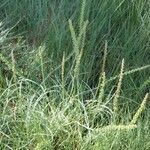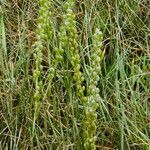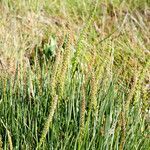Plants 2–8 dm; lvs erect, to 5 dm, 1–3 mm wide; raceme1–4 dm, the curved erect pedicels 5 mm, decurrent as narrow ridges along the rachis; tep 6, 1–2 mm; stamens 6; ovaries and fr ovoid-oblong, 5 mm at maturity; carpels rounded at the base, each one concave along the back and sharply angled on the margins, the fr-cluster thus appearing narrowly 12-winged; seldom the alternate carpels small and sterile; stigmas radiating, persistent; axis between the carpels very slender; 2n=12, 24, 36, 48, 76, 96, 120, 144. Brackish or fresh marshes and bogs; circumboreal, s. in Amer. to N.J., O., Io., Nebr., and Mex.; Patagonia. May–Aug. (T. elatum, T. gaspense, below high tide from Nf. to ne. Me. and sw. N.S.)
Herbs, perennial, ± robust; rhizome short, stout, clothed with sheaths of old leaves. Leaves (4-)7-30 cm × 1-4 mm. Scape erect, stout; racemes with ± densely arranged flowers. Flowers on short pedicels ca. 1 mm (2-4 mm after anthesis); perianth segments green, orbicular to ovate, ca. 1.5 mm. Carpels all fertile. Fruit ascending, not appressed to scape, oblong-ovoid, 3-5 × ca. 2 mm, base rounded. Fl. and fr. Jun-Oct. 2n = 24, 28, 36, 48, 80, 120.
A herb. It keeps growing from year to year. There are small tubers underground. It has a stout underground stem or rhizome. The leaves are narrow and thick. There are about 7 leaves that are 30 cm long by 1-4 mm wide. The flowers are greenish. They are 2-3 mm across. The fruit are 3-4 mm across.





